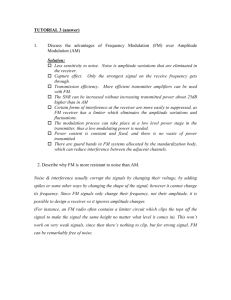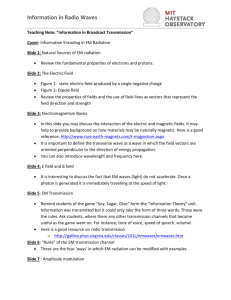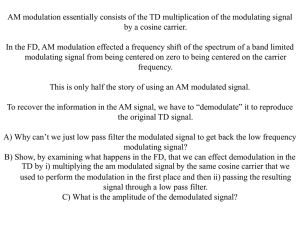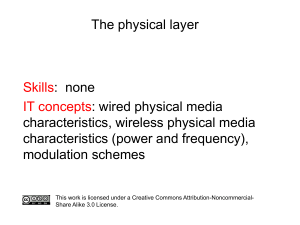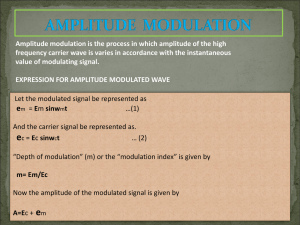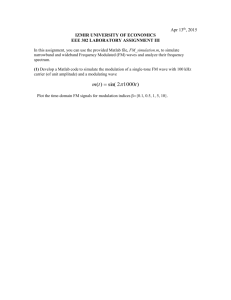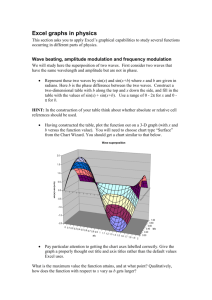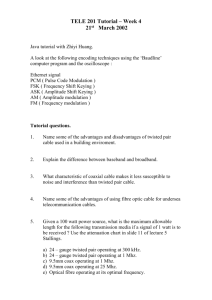Introduction to Communication System using Scilab
advertisement
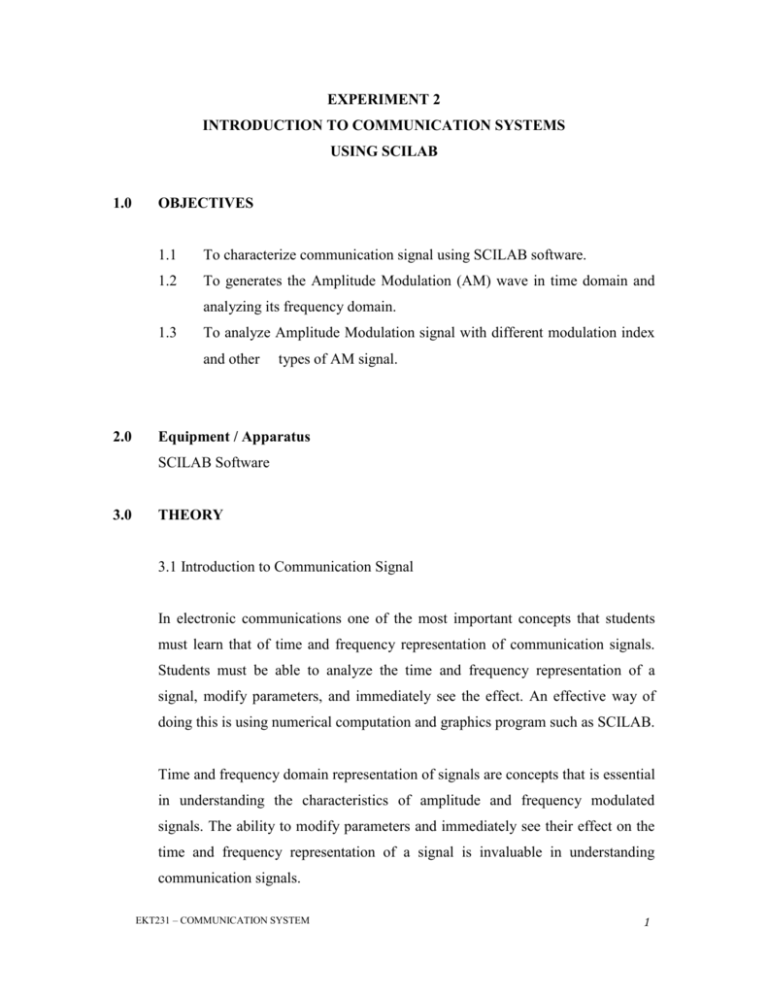
EXPERIMENT 2 INTRODUCTION TO COMMUNICATION SYSTEMS USING SCILAB 1.0 OBJECTIVES 1.1 To characterize communication signal using SCILAB software. 1.2 To generates the Amplitude Modulation (AM) wave in time domain and analyzing its frequency domain. 1.3 To analyze Amplitude Modulation signal with different modulation index and other 2.0 types of AM signal. Equipment / Apparatus SCILAB Software 3.0 THEORY 3.1 Introduction to Communication Signal In electronic communications one of the most important concepts that students must learn that of time and frequency representation of communication signals. Students must be able to analyze the time and frequency representation of a signal, modify parameters, and immediately see the effect. An effective way of doing this is using numerical computation and graphics program such as SCILAB. Time and frequency domain representation of signals are concepts that is essential in understanding the characteristics of amplitude and frequency modulated signals. The ability to modify parameters and immediately see their effect on the time and frequency representation of a signal is invaluable in understanding communication signals. EKT231 – COMMUNICATION SYSTEM 1 3.2 Amplitude Modulation (AM) Amplitude modulation is the kind of modulation that is commonly used in AM radio broadcasting, short-wave radio communications and telephone systems. It is produced as the product of mixing 2 different frequencies, a lower frequency called modulating signal ( m ) and a higher frequency called carrier signal ( c ), through a balanced modulator circuit or mixer. The AM wave produced in this manner is also called “ Double-Sideband Full Carrier “ or simply AM DSBFC. It is shown as in Fig 1.1. Fig 1.1 : Generation of AM wave. The instantaneous modulating frequency signal equation can be expressed as, (t) Vsin( 2 f t) m m m ---- (1.1) where Vm is the peak amplitude of the modulating signal and f m is the frequency of the modulating signal. Also, the instantaneous carrier frequency signal equation can be expressed as, (t) V 2 fct) c csin( EKT231 – COMMUNICATION SYSTEM ---- (1.2) 2 where Vc is the peak amplitude of the carrier signal and f c is the frequency of the carrier signal. Then, the instantaneous AM wave equation produced can be shown as, am (t ) [Vc Vm sin( 2f mt )] sin( 2f ct ) If we consider the modulation index, m --- (1.3) Vm V mVc , Vc , hence m then substitute Vm into equation 1.3, the instantaneous AM wave equation would be, ( t ) V mV sin( 2 f t )] sin( 2 f t ) c m c amc V [ 1 m sin( 2 f t )] sin( 2 f t ) c m c --- (1.4) Modulation Index (m) The modulation index (m) also can be determined by AM wave output waveform shown as in Fig.1.2 Fig.1.2 : AM wave output waveform The modulation index, EKT231 – COMMUNICATION SYSTEM V V m max min V V max min ----- ( 1.5) 3 E E max c m and where V V E E min c m Normal modulation index operation, 0 m 1. If m 1 , over-modulation will occur. 3.2 Amplitude Modulation (AM) in SCILAB AM Definition: Amplitude modulation is a process of varying the amplitude of a radio frequency (RF) carrier wave by a modulating voltage or audio signal which usually consists of a range of audio frequencies, for example speech or music signals. Why we have to modulate a signal for transmission. There are two reasons for modulation 1) law of electromagnetic propagation and 2) the simultaneous transmission of different signal. There are many different types of AM, such as Double Sideband Suppressed Carrier (DSB-SC) and Single Sideband (SSB). The modulation of a carrier signal will be performed in this lab which is using SCILAB. The Spectral calculation will be made using the mtlab_fft () function. The SCILAB environment can be effective tool for viewing effects of various form of modulation. In the following exercise, the modulated signal will examine in both the time and frequency domain. EKT231 – COMMUNICATION SYSTEM 4 4.0 EXAMPLE Example 1: 1. Equation 1 below is a sinusoidal expression for amplitude modulation signal. V ( t ) ( E E Sin ( t ) E Sin ( t ) E Sin ( t )) Sin ( t ) AM c m 1 m 1 m 2 m 2 m 3 m 3 c Compute the expression using Scilab to analyze the signal in Time Domain. Given the carrier frequency is 500 Hz and the amplitude is 4V. It is modulated by a signal made up of three sinusoidal or modulating signals with the following frequencies:- fm1 = 400 Hz , Em1 = 5 V ; fm2 = 250 Hz , Em2 = 2 V ; fm3 = 125 Hz , Em3 = 8 V Solution // generate time domain signal t = 0:0.01:1; // declare interval // insert all the information given Ec = 4; Em1 = 5; Em2 = 2; Em3 = 8; fm1 = 400; fm2 = 250; fm3 = 125; fc = 500; // Amplitude modulation Equation EKT231 – COMMUNICATION SYSTEM 5 A= Ec+Em1*sin(((2*%pi)*fm1)*t)+Em2*sin(((2*%pi)*fm2)*t)+Em3*sin(((2*%pi)*fm3 )*t); Vam = A .*sin(((2*%pi)*fc)*t); scf(1); // figure1 plot (1:size(A,2),A); scf(2); //figure2 plot(1:size(vam,2),Vam) Figure 1: Carrier Frequency Figure 2: Time Domain representation of AM with a modulation signal composed of three sinusoids plotted by SCILAB EKT231 – COMMUNICATION SYSTEM 6 The frequency domain of the complex AM signal can be obtained by taking the Fast Fourier transform of the time domain signal. The expression for evaluating FFT using SCILAB is shown below. Vf = abs(mtlb_fft(vam,2048))/1024; scf(3); //figure3 plot(Vf) NOTE: command scf() also can use subplot() 210 , 211 for graph scale, can use any number The FFT result, display the three separate frequency component of the modulation signals. Their frequency and amplitude characteristic are present of the frequency representation. This information is not evident in the time domain representation. Figure 3: Frequency Domain representation of AM with a modulation signal composed of three sinusoids. EKT231 – COMMUNICATION SYSTEM 7 Example 2: With the following data, use SCILAB to generate and display an Amplitude Modulation signal. Carrier frequency fc = 5 kHz Amplitude Carrier frequency = Ac = 9 V Sampling time = 100 ms Modulating frequency =500 Hz Amplitude Modulating Signal Am = 4.5 V Hint : 2ft Solution // generate carrier signal fc = 5000; Ac = 9; t = linspace(0,10*(10^(-3)),500); Vc = Ac*sin(((2*%pi)*fc)*t); subplot(411) plot(t,Vc) // generate modulating signal fm = 500; Am = 4.5; Vm = Am*sin(((2*%pi)*fm)*t); subplot(412) plot(t,Vm) // generate modulation signal with index modulation m = 0.5 m = Am/Ac; Vt = (Ac*(1+m*sin(((2*%pi)*fm)*t))) .*sin(((2*%pi)*fc)*t); subplot(413) plot(t,Vt) EKT231 – COMMUNICATION SYSTEM 8 Figure 4) i) Carrier Signal ii) Modulating Signal EKT231 – COMMUNICATION SYSTEM iii) Amplitude Modulation Signal 9 5.0 EXERCISE 1. Generate Amplitude Modulation signal for index modulation, m<1 , m = 1 and m > 1. 2. Use SCILAB to produce AM wave with the following specification Modulating Wave Sinusodal Modulation Frequency 1kHz Carrier frequency 20kHz Percentage Modulation 75% 3. In Double Side Band – Suppressed Carrier (DSB-SC) modulated wave, the carrier is suppressed and both sideband are transmitted in full. The signal is produced simply by multiplying the modulating wave by the carrier wave. Given, carrier signal, Vc(t) = 10 Sin 10000t , Modulating signal Vm(t) = 5 Sin 1000t and the modulation index m = 1. a) Generate and display the DSB-SC modulated wave (time domain) b) Computed and display the spectrum of the modulated wave. (frequency domain.) EKT231 – COMMUNICATION SYSTEM 1 0

